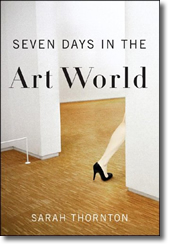Book Review: Seven Days in the Art World

Thornton, Sarah. Seven days in the art world. W. W. Norton, 2008.
The contemporary art world is characterized by six roles: artist, dealer, curator, critic, collector and auction-house expert. In this “symbolic economy,” creativity is commercialized and cultural worth is debated rather than determined by wealth. There is an overriding principle that nothing is more important than the art itself, yet there are contradictory hierarchies based on qualities such as fame, credibility, institutional affiliation, education and wealth.
Seven Days in the Art World describes this world through seven narratives set in six cities in five countries. Each chapter is a day-in-the-life account of the art world’s players and institutions. It begins with a Christie’s auction in New York. Among the people profiled is a Duke alumna who consigned 99 works from her parents’ collection of 600. In her Art 101 class at Duke, “all these slides went by of artists whose work we had in the house. We had never been told that they were valuable or famous. I had no idea.”
The art world is revealed through a day at the offices of Artforum International, the influential magazine for contemporary painting and sculpture; at a competition for the Turner Prize in the boardroom of the Tate Britain; and at an artist’s studio in Tokyo, among others. Author Thorton’s profiles bring clarity to a world of nuance and paradox.
© Reviewer: Meg Trauner & Ford Library – Fuqua School of Business.
All rights reserved.